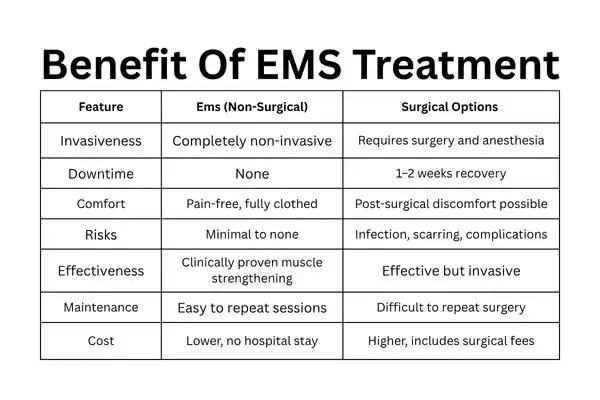Regain Control. Live Confidently.
Effective, modern treatment options for mixed urinary incontinence (stress + urgency).
Whether you leak when you cough, laugh or have sudden, urgent trips to the bathroom, there are non-surgical and surgical options — including a cutting-edge, non-invasive electromagnetic therapy called EMS.

Mixed urinary incontinence (MUI) means symptoms of both stress urinary incontinence (SUI) — leakage with physical activity — and urgency urinary incontinence (UUI) — leakage associated with a sudden, strong urge. Management usually starts with conservative measures (lifestyle changes and pelvic-floor muscle training) and advances to devices or surgery when symptoms persist.
The EMS chair treatment uses electromagnetic energy to trigger powerful pelvic floor muscle contractions, helping women of all ages strengthen their pelvic floor muscles and pelvic muscles, improve bladder control, and reduce urine leaks caused by stress incontinence, urge incontinence, or pelvic organ prolapse—supporting daily activities and overall confidence, while addressing individual needs, minimizing dependence on incontinence products, and being guided safely through every step of the way with awareness of any possible risks; complementing traditional pelvic floor exercises and care for related medical conditions.
EMS uses pulsed electromagnetic fields (HIFEM) delivered through a chair to stimulate pelvic-floor neuromuscular tissue and cause involuntary, supramaximal pelvic-floor muscle contractions. Those contractions are intended to improve muscle strength and neuromuscular control — similar in effect to many Kegel exercises but performed non-invasively. Clinical trials and device evaluations report improvements in the frequency of leakage episodes and quality of life for many patients.
Typical Mixed Incontinence Treatment Course
Protocols vary by clinic and by study. Standard real-world courses are six sessions (about 2 per week over 3 weeks), or protocols used in some trials are 6–8 sessions. Your clinician will confirm a personalised plan based on symptom severity and response.
Safety & who should avoid EMS
EMS is cleared by the FDA (510(k)) for the treatment of urinary incontinence; it’s generally well-tolerated. Contraindications commonly include pregnancy, implanted electronic devices (e.g., pacemaker, ICD), certain metallic pelvic implants and active pelvic infection. Muscle soreness and tingling are common, mild, and temporary side effects. As with any therapy, discuss medical history and devices with your clinician.
An overactive bladder is one of the most common types of urinary incontinence, often causing an urgent need to urinate, urine leakage, and disruption to daily life, especially in those with weak pelvic floor muscles, limited mobility, or other health conditions affecting the urinary tract or bowel movements; while pelvic floor muscle training, specialist nurses, and electromagnetic technology can offer effective treatment and significant improvement in pelvic floor function, sexual health, and overall quality of life by addressing pelvic floor issues, hormonal changes, and the physical impact of overactive bladder syndrome, overflow incontinence, or leakage of urine due to a full bladder or bowel problems—helping reduce social isolation and manage different types of urinary incontinence safely, with guidance on possible risks, litres of fluid intake, and any further questions about one’s specific type of urinary incontinence.

Q: Is EMS FDA-cleared?
A: Yes — EMS has 510(k) FDA clearance for treating urinary incontinence and is widely used in clinics; manufacturers and regulatory documents confirm clearance. As with any medical device, ask your clinic to show its regulatory and clinical documentation.
Q: How many sessions will I need, and how long are they?
A: Typical courses are eight to ten sessions (about 28–30 minutes each), often scheduled 1–2 times per week. Your clinician will tailor the plan.
Q: Is it painful?
A: Most patients report sensations of pelvic-floor muscle contractions (some describe it like an intense Kegel), with minimal discomfort. Occasionally, there’s short-lived muscle soreness afterwards.
Q: How soon will I notice improvement?
A: Some people notice improvements after the first few sessions; for others, it takes the whole course. Degree and timing of benefit vary by individual and symptom type. Trials report symptom and quality-of-life improvements in many participants.
Q: Are there people who should NOT have EMS?
A: Yes — contra-indications commonly include pregnancy, implanted electrical devices (e.g., pacemaker/ICD), metallic pelvic implants, and active pelvic infections. Always review full medical history and implants with your provider.
Q: Can EMS replace surgery?
A: It can be an effective non-surgical option for many patients and may reduce or eliminate symptoms for some.